Ants, Cockroaches & Insects Pest Control
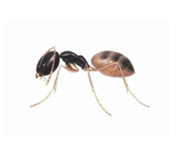
Ghost Ants
Ghost Ants (Tapinoma melanocephalum) are small tropical ants and are a relatively new species of ant to the UK. They and are thought to have arrived in the UK from the USA and are now increasing in numbers. Like other exotic insect pests, they can only survive in the UK within heated buildings.
They are not known to damage properties or belongings, but they are commonly found in kitchens and bathrooms and are potential carriers of disease causing organisms.
Biology
Ghost Ants are small ants, the workers being only 1.5mm long and are identifiable from their colouration, having a dark head and thorax (front half) and white or translucent abdomen (rear half). Within buildings, Ghost Ant nests are typically built in wall and ceiling cavities but can also be found in plant pots. The nests can contain a several queens and many thousands of worker ants, and there are usually multiple nests within the colony. They prefer sweet foods and follow trails created by other ants as they search for food and retrieve it to their nests.
Ghost Ant Removal
The control of Ghost Ant colonies can be difficult and is best left to a professional. Pest Defence provides a safe and effective treatment for the eradication of Ghost Ants by a thorough survey and use of approved high-performance professional baits which they take back to their nest sites. Please call Pest Defence for advice or a quotation for the eradication of Ghost Ants.
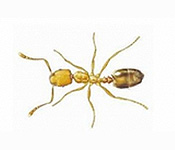
Pharaoh Ants
Pharaoh Ants (Monomorium pharaonis) are small tropical ant which have now achieved worldwide distribution. In the UK they are the most commonly found ‘tropical ant’, but can only survive within heated buildings.
They are a serious pest in hospitals and multiple occupancy buildings and are known to carry and spread disease causing organisms.
Biology
Pharaoh Ants are small ants, the workers being only 1.5-2.0mm long. They have a yellow-red colouration with a darker abdomen (rear half).
The nests are small in size, small enough to fit inside a matchbox, but they contain multiple queens and can contain huge numbers of workers, up to 300,000. The worker ants follow trails created by other ants in search of food and can travel considerable distances from the nest site. Pharaoh Ants feed on a diversity of food types and will readily switch their food preference between sugar and protein based foods. As the nests increase in size they have the tendency to multiply by forming sub-colonies as the queens leave the nest with a proportion of the workers to create a new separate nest, a process called ‘budding’.
The ‘budding’ of new nests is also a survival behaviourism and is commonly stimulated when the environment outside the nest becomes hostile, the strategy being that there is a greater likelihood of the colony surviving if it divides in multiple nest groups. This is an important factor to consider when treating Pharaoh Ants because conventional insecticidal spray and dust formulations will kill a proportion of worker but are unlikely to eliminate the nest completely. The effect is to stress the nest causing it to divide into sub-colonies which then disperse into the building structure. There may initially be a reduction in ant activity as a result of the insecticidal treatment, but the Pharaoh Ants will return in greater numbers as the multiple nests increase in size.
Pest Control for Pharaoh Ant Removal
The control of Pharaoh Ant infestations can be difficult and is best left to a professional. Conventional insecticidal sprays, aerosols, and dust formulations should not be used. At Pest Defence we are qualified and experienced in eradicating Pharaoh Ant infestations safely, quickly and cost-effectively. Pest Defence employs a range of approved high-performance professional baits which the ants take back to their nest sites to feed and destroy the queens, in some circumstances the extermination of Pharaoh Ant infestations can be eliminated in as little as two weeks.
Please call Pest Defence for advice or a quotation for the eradication of Pharaoh Ants.
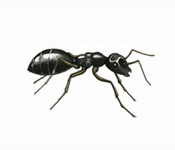
Common Black Ants
The Common Black Ants, also known as the Garden Ants (Lasius niger) are native to the UK and are by far the most commonly found ant in and around homes and businesses.
They are not known to cause significant damage properties or belongings, although the excavations at their nest sites have been known to undermine block pavements. They are attracted to sweet tasting foods and drinks and can be a significant pest in homes and gardens and to catering businesses such as pubs, restaurants, and bakeries. The sudden emergence of thousands of flying ants at certain times during the summer can cause discomfort and distress, and foraging ants searching for food in kitchens and food stores are also potential carriers of disease causing organisms.
Biology
Black (Garden) Ants are moderate sized ants, the workers being 3-4mm long, the winged queens being about 10mm, and the smaller winged males being 6-7mm long. Common Black Ants are ubiquitous insects and are widely distributed. Ant nests are commonly found in most gardens, footpaths and around buildings, particularly in sunny locations where there is dry and sandy soil. Although the majority of nest sites are outdoors, they can form their nests in wall voids and under the foundations of homes and buildings where they are likely to be a greater and perpetual nuisance.
The nest sites are often marked by small piles of soil and debris which have been ejected from the nest and worker ants are often found active in and around these soil heaps. The worker ants travel considerable distances in search of food by following chemical (pheromone) trails paths created by other ants. Common Black Ants are particularly attracted to sweet sugary foods such as jam, syrups, and soft drinks and large numbers of ants can suddenly appear on in kitchens and on food tables/worktops feeding on sweet foods or food spillages.
During mid-summer the winged queen ants (larger winged ants) and males (smaller winged ants) emerge in large numbers to mate. The flying ants are clumsy and are a nuisance and irritation to people as they land on their skin and clothing and get caught in people’s hair. Public events have been known to be cancelled because of these swarms of flying ants. However, the nuptial flights are relatively short lived and occur on only a few days during the summer. Once mated, the impregnated queens return to earth, loose their wings, and find a suitable location to start building a new nest. The nests of the Common Black Ant can live for up to fifteen years.
In some circumstances, if the ants’ nest is under the floor of a building or in a wall cavity, the mass of flying ants will emerge inside the building. The larger flying ants, accompanied by the smaller worker are seen erupting from the nest and homes and businesses find the flying ants climbing walls, doors, windows and curtains as the ants attempt to leave.
Pest Control for Common Black Ants or Garden Ants
Ants are the most commonly reported pest problem found in homes in the United Kingdom today and people often try to deal with the problem themselves using off the shelf ‘Amateur Use’ ant products. However, treatment of Common Black Garden Ant colonies using insecticidal sprays, powders, and baits can provide only short term solutions and sometimes no effect at all.
‘Professional Use’ insecticidal products have a higher efficacy and the knowledge and experience of a professionally trained pest controller will also increase the likelihood of greater and longer term success.
Pest Defence provides a safe and effective treatment for the eradication of Common Black Garden Ants. Our Professionally Qualified and Experienced Pest Controllers will carry out a thorough survey to identify the source of the ant problems and the location of the ant nest sites from which they are originating. Pest Defence will only use insecticidal products that are known to be highly effective against ants and are also approved by the HSE (Health & Safety Executive) for safe use in homes and businesses in the UK, including professional ant baits that are taken back to the ants’ nest and can completely eradicate the ants’ nest within as little as two weeks.
Please call Pest Defence for advice or a quotation for the eradication of Common Black Garden Ants.
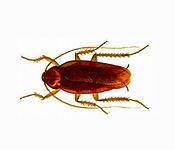
American Cockroaches
The American Cockroach (Peripleneta americana) is one of the largest cockroaches found indoors, although infestations of American Cockroaches in the UK are uncommon.
American Cockroaches originate from the tropics and are commonly introduced into the UK amongst cargos of exotic fruits and plants. Importers of such exotic fruits and plants will attempt to eliminate any unwanted pests within these commodities but occasionally the cockroaches survive procedures and find their way into homes and businesses. However, American Cockroaches are not particularly cold tolerant and they are not well-established in the UK. All infesting species of cockroaches are significant public health pests because of their high potential to carry and transmit disease causing organisms associated with food poisoning.
Common places where American Cockroaches will survive and proliferate in the UK are typically humid and heated environments such as can be found in greenhouses, zoos, and leisure swimming pools, and some boiler rooms and sewers.
Biology of the American Cockroach
The adults can be 30-50mm long and are fully winged. The immature nymphs are wingless and there can be up to twelve nymphal stages (instars) before they develop into the adult cockroach. Development from egg to adult can take longer than one year, so infestations of American Cockroaches grow slowly compared to other cockroach species. The nymphs and adults are both identifiable by a dull yellow band around the pronotum (at the head end of the body). Both adult and nymphs of the American Cockroach are highly active and the adults are capable of flight in hot and humid conditions.
The egg capsules (ootheca) of the American Cockroach can contain up to 16-18 separate eggs and are dropped or stuck to a suitable surface by the female cockroach. Infestations of American Cockroaches often begin from an egg capsule that has been introduced on imported goods from a tropical region. However, it is also known for people to bring cockroaches home amongst luggage after visiting exotic locations.
Pest Control for American Cockroaches in the UK
Pest Defence provides a safe and effective treatment for the eradication of American Cockroaches. Our Professionally Qualified and Experienced Pest Controllers will carry out a thorough survey to identify the cockroach harbourages and the extent of the infestation. Pest Defence will only use insecticidal products that are known to be highly effective against American Cockroaches and are also approved by the HSE (Health & Safety Executive) for safe use in homes and businesses in the UK. Professional quality cockroach gel baits are highly effective in eradicating cockroach infestations, and insecticidal ULVs, mists or fogs can be used to achieve a fast reduction of cockroach numbers.
Please call Pest Defence for advice or a quotation for the eradication of American Cockroaches.
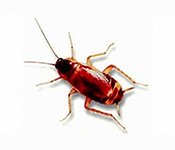
Brown-Banded Cockroaches
Adult Brown-Banded cockroaches are about 15mm in length. The species is similar in appearance to the German Cockroach but have two light, yellow-brown bands that run across their body, giving the cockroach its name. The bands are much easier to see on the nymphs because they lack wings to obscure them.
Biology
Brown-banded cockroaches are found in all parts of the home, and seem to prefer hiding places off the floor. The insects prefer a warmer environment than German cockroaches and are therefore not as common in the UK.
Pest Control
The pest control experts at Pest Defence we will carry out a thorough survey to identify the extent of the brown-banded cockroach infestation. As with all the cockroach species, a combination of cockroach traps, gels and residual insecticides is the main approach. The success of our cockroach treatment will be monitored using pheromone baited cockroach monitoring traps.
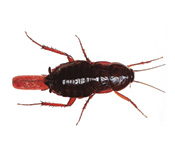
Oriental Cockroaches
The Oriental Cockroach (Blatta orientallis) is the second most commonly encountered cockroach found indoors in the UK, the most common being the German Cockroach. Despite its name, the Oriental Cockroach is believed to have originated from either North Africa or Southern Russia.
Oriental Cockroaches prefer hot and humid conditions and can only survive the UK winter within heated buildings, although they are fairly cold tolerant and can be found outdoors during summer months often associated with drains and refuse. Oriental Cockroaches cannot climb smooth surfaces and are more often seen at floor level although they can climb brickwork or any surface that provides a similar rough surface for grip.
Oriental Cockroaches are predominantly nocturnal and feed on all manner of discarded and decaying foods but prefer food with a high starch and water content. Where infestations of Oriental Cockroaches exist, a night inspection will often reveal large numbers of cockroaches feeding in kitchens, amongst refuse, and around drains, wherever grime and food waste exists.
Oriental Cockroaches are a major health pest because of their association with filth and decaying food, and because they feed and live in environments where disease causing organisms are present. Pathogenic bacteria such as Salmonella, Streptococcus, E Coli and Staphylococci are present on the bodies and inside the guts of cockroaches and can be transmitted to food in their faeces or just through contact. Food can also be contaminated with dead cockroaches, their cast exoskeleton skins and their faeces. Oriental Cockroaches can carry up to 33 types of disease causing bacteria including Gastroenteritis, Salmonella, Diarrhoea, Shigella and Dysentry.
Biology of the Oriental Cockroach
Oriental Cockroaches are relatively large cockroaches with the adult males being up to 25mm long and the longer adult females being 32mm long. Oriental Cockroaches have a shiny dark colouration varying from dark reddish brown to black. The female Oriental Cockroaches have small vestigial wing pads behind the head and the males have wings that cover about ¾ of the body, but neither they or nymphs can fly.
The egg capsule (oothecal) of the Oriental Cockroach is about the size of a coffee bean and contains 16 eggs, which is carried for 1-2 days before it is dropped near a food supply. The first instar nymphs hatch after approximately 2 months at room temperature and then develop through 7 to 10 instar stages before developing into the adult cockroach. The female Oriental Cockroach can produce up to 150 young per year and the developmental time from egg to adult is between 6 months to 2 years.
The adults and nymphs of the Oriental Cockroach have similar feeding habits and are usually seen together. However, the adults can travel for up to 100m in search of food and can enter homes, restaurants, pubs, and other businesses in the course of their foraging, particularly during summer months when they are active outdoors. Infestations of Oriental Cockroaches can begin from a ‘time bomb’ egg capsule that has been dropped by a foraging female cockroach to release the sixteen young nymphal cockroaches when they hatch.
There is an old wives’ tale that says that ‘if you stamp on a cockroach you will take an infestation home with you’, which is borne from the likelihood of a cockroach egg capsule becoming trapped in the tread of your shoe if you happen to step on one.
Pest Control for Oriental Cockroaches in the UK
Pest Defence provides a safe and effective treatment for the eradication of Oriental Cockroaches. Our professionally qualified and experienced pest controllers will carry out a thorough survey to identify the cockroach harbourages and the extent of the infestation. Pest Defence will only use insecticidal products that are known to be highly effective against Oriental Cockroaches and are also approved by the HSE (Health & Safety Executive) for safe use in homes and businesses in the UK. Professional quality cockroach gel baits are highly effective in eradicating cockroach infestations, and insecticidal ULVs, mists or fogs can be used to achieve a fast reduction of cockroach numbers.
Please call Pest Defence for advice or a quotation for the eradication of Oriental Cockroaches.
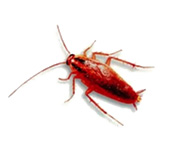
German Cockroaches
Adult German cockroaches are about 17mm long and light brown except for the shield behind the head marked with two dark stripes, which run lengthwise on the body. The nymphs are wingless and nearly black with a single light stripe running down the middle of the back. Egg capsules are light tan.
Biology
Egg cases are carried by the female until just before hatching and each female may produce four to six cases during her lifetime, each containing 30 to 40 eggs. Eggs hatch in 28 to 30 days, and nymphs develop in 40 to 125 days.
Female cockroaches live about 200 days (slightly longer than the male). The German cockroach produces more eggs and has more generations per year (three to four) than any other cockroach, and only a few individuals are needed to develop into troublesome infestations.
Pest Control
The pest control experts at Pest Defence we will carry out a thorough survey to identify the extent of the German cockroach infestation. As with all the cockroach species, a combination of cockroach traps, gels and residual insecticides is the main approach. The success of our cockroach treatment will be monitored using pheromone baited cockroach monitoring traps.
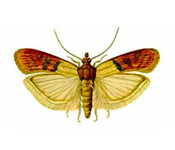
Indian Meal Moth
Adult moths are about 8 to 10mm long when at rest and have a wing spread of about 18 to 20mm. When viewed from above with the wings folded over the back, the outer 1/3 of the wing appears reddish-brown or bronze coloured ‘at the wing tips’ while the inner 2/3 of the wing ‘at the basal portion’ is light grey to ochre-yellow. Also, the head and thorax are reddish-brown and the hind wings grey. Brown-headed larvae are dirty white, sometimes tinged pink or green.
Biology
The female moth lays between 60 and 300 eggs, singly or in clusters, on or near the foodstuffs. Eggs hatch in 2 to 14 days with larvae or ‘tiny whitish caterpillars’ dispersing within a few hours. Larvae move to foodstuffs, and feed in or near a tunnel-like case of frass and silk which they web together. Under good conditions, the entire life cycle requires six to eight weeks and can be active all year round. However, in cold climates, larvae over-winter and pupate in March.
Pest Control
Pest Defence can provide advice and help in identifying and treating infestations of Indian Meal Moth. Controlling this pest requires careful inspection of all stored cereal foods and dry foods and discarding the heavily infested material. Pheromone baited moth traps are useful for monitoring moth numbers and pesticide free mating disruption systems can be employed to help eliminate moth infestations.

Common Clothes Moth
Slightly larger than the Case-bearing moth, adults can reach up to 7mm. The moths are a light, shiny gold colour, with a tuft of reddish hairs on the head.
Biology
Similar to Case-Bearing Clothes Moth.
Pest Control
Pest Defence can provide advice and help in identifying and treating infestations of Clothes Moth. Treatment is similar for all the textile moths. Carefully examine any carpets and clothes made from wool or other natural fibres for larvae, pupal cases, adult moths, and for damage caused by the feeding larvae. Holes appearing in carpets and clothes is often the first sign of a moth infestation. Damaged clothing should be discarded or washed at 60º, and an approved residual insecticide can be applied to carpets, particularly the vulnerable areas under furniture and around carpet edges. Birds nests are sometimes the source of moth infestations and should be removed and treated if found.
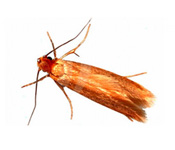
Case Bearing Moths
The moths are approximately 5mm in length. Forewings are yellowishbrown, and there are usually three distinct, dark dots on the outer third of each wing. Hind wings are smaller, lighter, and fringed with hair and scales. Eggs are whitish, and larvae are opaque-white with brown heads.
Biology
Clothes moths rarely fly to lights at night and instead prefer darkness, such as a closet or storage chest. Any clothes moths fluttering around the house are probably males, because females travel by running, hopping, or trying to hide in the folds of clothing. The female lays 100 – 150 white eggs on the surface of the fabric which will hatch into larvae in approximately 5 days. The period of larval development is usually 6 weeks, during which time the larvae actively feed on the fabric, however, this can take considerably longer under cooler conditions.
Pest Control
Pest Defence can provide advice and help in identifying and treating infestations of case bearing moth. Treatment is similar for all the textile moths. Carefully examine any carpets and clothes made from wool or other natural fibres for larvae, pupal cases, adult moths, and for damage caused by the feeding larvae. Holes appearing in carpets and clothes is often the first sign of a moth infestation. Damaged clothing should be discarded or washed at 60º, and an approved residual insecticide can be applied to carpets, particularly the vulnerable areas under furniture and around carpet edges. Birds nests are sometimes the source of moth infestations and should be removed and treated if found.
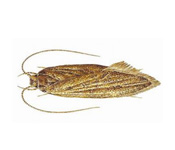
Brown House Moth
Shiny gold/brown moth approximately 10mm in length. The wing tips have a hairy/feathery appearance and the wings themselves have dark brown spots (although these can easily be rubbed off).
Biology
The larvae of these insects can cause considerable damage when they feed on articles that contain wool, mohair, fur, hair, feathers or other products of animal origin. The brown house moth will also feed on other organic debris including dried or mouldy food waste. The female lays up to 500 white eggs on the surface of fabrics which can hatch into larvae in as little as 10 days. The period of larval development is 6 weeks (under ideal conditions), during which time the larvae actively feed on fabrics etc.
Pest Control
Pest Defence can provide advice and help in identifying and treating infestations of House Moth. Treatment is similar for all the textile moths. Carefully examine any carpets and clothes made from wool or other natural fibres for larvae, pupal cases, adult moths, and for damage caused by the feeding larvae. Holes appearing in carpets and clothes is often the first sign of a moth infestation. Damaged clothing should be discarded or washed at 60º, and an approved residual insecticide can be applied to carpets, particularly the vulnerable areas under furniture and around carpet edges. Birds nests are sometimes the source of moth infestations and should be removed and treated if found.
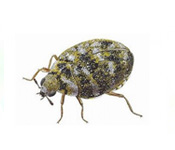
Varied Carpet Beetle
Adults are 2 – 4 mm long and variable black or brown with mottled yellow or white markings. A pest primarily in the home, food and museum sectors (the latter causing a significant threat to collections).
Biology
Mating occurs immediately after emergence. The female produces up to 100 eggs over a period of two weeks. Larval development lasts for 10-30 days. Larval forms (known as the ‘Woolly Bear’) can reach 4 – 5 mm in size before pupation and can cause considerable damage to products such as wool, fur, leather, silk and animal skins, and occasionally cereal based food products. Adult carpet beetles usually live outdoors on pollen and nectar, and thrive in situations where they remain undisturbed, such as under carpets, bird and rodent nests and animal remains.
Pest Control
Pest Defence can provide advice and help in identifying and treating infestations of Carpet Beetle. Treatment is similar for all the textile pests. Carefully examine any carpets and clothes made from wool or other natural fibres for larvae (woolly bears), pupal cases, adult beetle, and for damage caused by the feeding larvae. Holes appearing in carpets and clothes is often the first sign of a carpet beetle infestation. Damaged clothing should be discarded or washed at 60º, and an approved residual insecticide can be applied to carpets, particularly the vulnerable areas under furniture and around carpet edges. Birds nests and animal carcasses are sometimes the source of moth infestations and should be removed and treated if found.
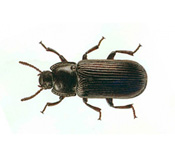
Mealworm Beetle
The Beetles are robust, black and nearly 18mm long, resembling many ground beetles in size, shape and colour. The larvae are distinct, being honey yellow in colour with a smooth, highly polished, hard, cylindrical (wormlike) body about 3mm thick and up to 28mm long at maturity.
Biology
Adult beetles are attracted to night-lights, are strong fliers, and are found in dark places. Each female lays about 275 eggs, which hatch into larvae in 4 to 14 days. Eggs are laid singly or in clusters during the spring over a period of 22 to 137 days. Larvae may spend up to two years in this stage depending on the environment. Individual larvae may wander far from the food source to pupate, making it difficult for homeowners to locate the source of infestation. Common sources are cornmeal, flour, cake mixes, cereals, meat scraps, dead insects, bran, litter from chicken houses and birds’ nests.
Pest Control
Pest Defence can provide advice and help in identifying and treating infestations of Yellow Mealworm Beetles. To control these pests, the infested area should be thoroughly cleaned to remove the debris on which the larvae fed (bird nests, food etc). Application of a broad spectrum residual insecticide will then normally control the problem.
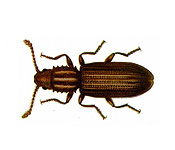
Saw Toothed Grain Beetle
The adult is a small, active, brown beetle, 2-3mm long, with a flattened body and six saw-toothed projections on each side of the thorax. Similar in appearance is the Merchant Grain Beetle which has a slightly different shape to the head and thorax.
Biology
The females live from 6 to 10 months and deposit upwards of 250 eggs in foodstuffs. Several generations may occur each year, as the life cycle requires only 3 to 4 weeks during the summer, when conditions are at their most favourable.
Pest Control
Pest Defence can provide advice and help in identifying and treating infestations of Stored Product Insect pests such as the Saw Toothed Grain Beetle. Controlling this pest requires careful inspection of all stored cereal foods, discarding the heavily infested material. Building fabric, machinery etc can then be sprayed using an approved residual insecticide.
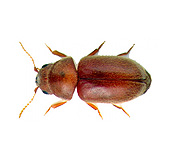
Tobacco Beetle
About 2.5mm in length, the adult beetles are oval and covered with small hairs which give them a silky, yellowish-brown colour. Adults are strong fliers and prefer subdued light and temperatures over 65 degrees F.
Biology
The larval stages of the beetle can feed on a variety of stored products including tobacco, grain, cereal products, ginger, raisins, dates, pepper, dried fish, drugs, and seeds. The female produces about 100 eggs and the entire life cycle can be completed in 45-50 days.
Pest Control
Pest Defence can provide advice and help in identifying and treating infestations of Stored Product Insect pests such as the Tobacco Beetle. The first step in control of the tobacco and biscuit beetles is to find the source of the infestation. This means inspecting all of the dried foods in the infested cabinets or drawers. Once the infested material is found, it should be destroyed. Insect Monitors are essential in commercial situations to highlight infestations. Infested commodities are usually destroyed, whilst the building fabric can be treated with residual insecticides.
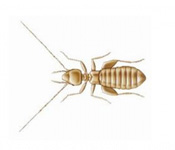
Booklice
Psocids are common but harmless insects. Yellow, brown, white or grey in colour and only 1mm long, most of the species are wingless. They are usually found in dark humid places such as kitchen cupboards, bathrooms, on drying plaster in new houses and on old books and stored papers in libraries and archival storage areas, where they feed on microscopic moulds.
Biology
Psocids live for about 6 months, during which time the female can lay up to 100 eggs laid separately at a rate of 1-3 per day. The eggs then hatch in 1-2 weeks depending on the surrounding humidity.
Pest Control
Pest Defence can provide advice and help in identifying and treating infestations of Booklice. Ideally the environment must be dried with dehumidifiers so that the environment is no longer suitable for Booklice. An insecticidal treatment with a broad spectrum residual insecticide can help to reduce their numbers.
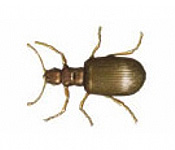
Plaster Beetle
Small reddish or black beetles often found weakly flying in homes during late summer. Plaster Beetles are from 1.5- 2.5 mm in length with ridged, wide wingcases.
Biology
Plaster beetles feed on mould or mildews and are attracted to anything that is musty smelling with newly constructed homes, damp areas in basements, bathrooms and damp commodities (such as grain), often affected. Eggs are laid singly and take approximately 5 weeks to complete the lifecycle.
Pest Control
Pest Defence can provide advice and help in identifying and treating infestations of Plaster Beetles. Ideally the environment must be dried with dehumidifiers so that the environment is no longer suitable for Plaster Beetles. An insecticidal treatment with a broad spectrum residual insecticide can help to control the beetle infestation.
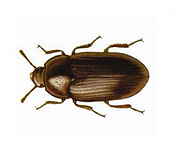
Lesser Beetle
Adult lesser mealworms are up to 6mm long, dark brown to black insects, with a distinctively dimpled thorax. The adults and larvae are often found in floor litter where they feed on poultry feed, dried bird droppings, and bird carcasses. Being a general scavenger, they can also be an occasional pest of stored products. In high numbers, in addition to being a vector for disease, the beetles can cause considerable structural damage as the larvae will often tunnel into polystyrene insulation materials or even wooden beams and supports in order to pupate.
Biology
Eggs are laid in batches and hatch in 4 to 5 days under typical room temperatures. The larval period can be as short as 8 weeks and following a 5 to 10 day pupal stage, the adult emerges. The average time from egg to adult takes about 80 days and the adults can live for several months.
Pest Control
Pest Defence can provide advice and help in identifying and treating infestations of the Lesser Mealworm Beetle in poultry sheds. Effective litter management can slow the development of these beetles and reduce the chances of having excessive build-up of numbers. The poultry houses can be treated with residual insecticides during the cleaning program between flocks. In non-poultry situations, infested goods and debris should be removed, followed by spraying with a broad spectrum residual insecticide.
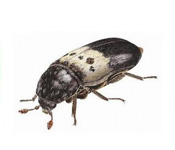
Larder Beetles
Adult larder beetles are about 8mm long and dark brown, with a broad, pale yellow, black-spotted band across the front portion of the wing covers. There are six black dots on this band, three on each wing cover, arranged in a triangle. The underside and legs are covered with fine, yellowish hairs. Other dermestes species include D. peruvianas (uniformly dark) and D. maculatus (black with patches of white hairs).
Biology
Females each lay about 135 eggs, which hatch in 12 or more days. Larvae prefer spoiled ham, bacon, dried beef and other meats. Larvae either bore into this meat or wander away to bore into wood, books and even metals such as lead and telephone cables to pupate. The life cycle requires 40 to 50 days.
Pest Control
Pest Defence can provide advice and help in identifying and treating infestations of Stored product Insect pests such as the Dermestid Beetles (Larder Beetle and Hide beetle). In domestic situations or industrial kitchens, an integrated programme of cleaning and spraying with a residual insecticide (paying attention to all cracks and crevices), will control most infestations.
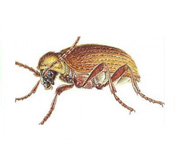
Australian Spider Beetle
Originating from Tasmania, this species now has full distribution throughout temperate zones of the world, although it favours the indoor environment. Associated with bird’s nests and stored foodstuffs, it is also present in many industrial food storage situations. The beetles are up to 3.5mm in length and have a thin waist, large abdomen and long legs, giving the insects its spider-like appearance.
Pest Control
Pest Defence can provide advice and help in identifying and treating infestations of Stored product Insect pests such as the Spider Beetles. Controlling this pest requires careful inspection of all stored cereal foods, discarding the heavily infested material. Good hygiene practices, stock rotation, quarantine of inbound stock and monitoring should be considered and application of an approved residual insecticide.
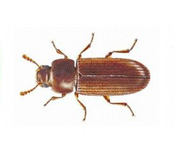
Rust Red Beetle
The insects are about 3-4mm and reddish-brown in colour. The confused flour beetle and the red flour beetle are similar in appearance and habits. Adult confused flour beetles have the antennae gradually enlarged toward the tip; the antennae of the red flour beetle have the last three segments abruptly enlarged. Confused Flour Beetle (Tribolium confusum) cannot fly, but Rust Red Flour Beetle (Tribolium castaneum) may fly. In addition, the eyes (when viewed underneath) of the T. confusum are separated by a space equivalent to 3 times the diameter of the eye, whereas in the T. castaneum, this gap is less than 2 times the diameter.
Beetles attack milled grain products such as flour and cereals. These beetles often hitchhike into the house in infested flour and can build up into large populations on food accumulations in cabinet cracks and crevices and in furniture. The life cycle requires one to four months when temperatures are favourable and the female may live for as long as 2 years.
Pest Control
Pest Defence can provide advice and help in identifying and treating infestations of Stored product Insect pests such as the Flour Beetles. Controlling Flour Beetle infestations begins with a thorough inspection to identify the infested foodstuff, usually flour. The infested material must be removed and destroyed and a thorough clean up is advised, using a vacuum cleaner to get into the cracks and crevices followed by a treatment using a broad spectrum residual insecticide. Insect monitors are essential in commercial situations to identify infestations at an early stage and monitor the success of the treatment.
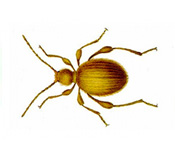
Golden Spider Beetle
Much larger than the Australian at up to 4.5mm long, has a roughly spherical shape and is covered in golden hairs and scales. Occurs in flour and feed mills, food warehousing and the domestic environment. Seldom seen in more than small numbers.
Adults are extremely cold hardy, but free water is essential to them. They are nocturnal in foraging behaviour. A widespread pest in the food industry, larvae can bore through many types of packaging. There are usually up to 2 generations per year and the average lifespan is 9-12 months.
Pest Control
Pest Defence can provide advice and help in identifying and treating infestations of Stored product Insect pests such as the Spider Beetles. Controlling this pest requires careful inspection of all stored cereal foods, discarding the heavily infested material. Good hygiene practices, stock rotation, quarantine of inbound stock and monitoring should be considered and application of an approved residual insecticide.
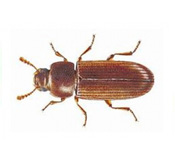
Confused Flour Beetle
The insects are about 3-4mm and reddish-brown in colour. The confused flour beetle and the red flour beetle are similar in appearance and habits. Adult confused flour beetles have the antennae gradually enlarged toward the tip; the antennae of the red flour beetle have the last three segments abruptly enlarged. Confused Flour Beetle (Tribolium confusum) cannot fly, but Rust Red Flour Beetle (Tribolium castaneum) may fly. In addition, the eyes (when viewed underneath) of the T. confusum are separated by a space equivalent to 3 times the diameter of the eye, whereas in the T. castaneum, this gap is less than 2 times the diameter.
Beetles attack milled grain products such as flour and cereals. These beetles often hitchhike into the house in infested flour and can build up into large populations on food accumulations in cabinet cracks and crevices and in furniture. The life cycle requires one to four months when temperatures are favourable and the female may live for as long as 2 years.
Pest Control
Pest Defence can provide advice and help in identifying and treating infestations of Stored product Insect pests such as the Flour Beetles. Controlling Flour Beetle infestations begins with a thorough inspection to identify the infested foodstuff, usually flour. The infested material must be removed and destroyed and a thorough clean up is advised, using a vacuum cleaner to get into the cracks and crevices followed by a treatment using a broad spectrum residual insecticide. Insect monitors are essential in commercial situations to identify infestations at an early stage and monitor the success of the treatment.
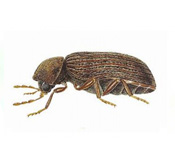
Biscuit Beetle
The beetles are about 2 – 3mm long and light brown to red brown in colour. Their bodies are covered with fine, silky hairs, and they have distinct grooves in their wing covers which can easily separate them from Tobacco beetle. Biscuit Beetles have antenna that end in three enlarged segments.
Biology
Similar to Tobacco Beetle.
Pest Control
Pest Defence can provide advice and help in identifying and treating infestations of Stored Product Insect pests such as the Biscuit Beetle. The first step in control of the Biscuit Beetle is to find the source of the infestation. This means inspecting all of the dried foods and food stores in the affected areas. Once the infested material is found, it should be destroyed. Insect monitors are essential in commercial situations to highlight infestations. Infested commodities are usually destroyed, whilst the building fabric can be treated with residual insecticides.
When tackling infestations of small insects it’s imperative that the job is definitive. The last thing you want is to pay for an extermination service, only for some remaining insects to repopulate and reappear not long after. That’s why you should choose a reputable extermination team with years of experience.
Here at Pest Defence our team work meticulously to ensure that any problem has been eradicated to a definitive end, whether the service needed is ant control, moth control, cockroach control or any other troublesome beetle or insects control. We achieve this by using some of the most advanced extermination methods in the industry, thanks to the wide-ranging skills and expertise of our team members. We cover a wide area across Essex including Brentwood, Colchester and Chelmsford.
Ant Infestation Control
Ant infestations can be tackled using a variety of professionally approved control measures. This includes using baits that the ant takes back to its nest and feeds to the queen. With the queen dead, and our eradication methods in place, the ant colony will slowly die off.
Cockroach Infestation Control
A cockroach infestation can have devastating consequences for the success and reputation of your business. Our aim is to work discreetly and efficiently so as not to compromise your business and its daily operations.
We start with a comprehensive survey of your premises so that we can identify the cockroaches involved and the source of the infestation. Our team of experts will then use their years of knowledge and experience to plan the appropriate remedy for your specific situation. Among our options, we have a broad spectrum of insecticides that are highly effective.
Other Insect Pest Control
We understand it can be difficult to identify the type of insect causing a problem, which is why here at Pest Defence we always include a comprehensive inspection of your premises to identify the pest involved. Be it moths, carpet beetles or cockroaches, our exterminators will always deliver effective insect control solutions in a professional and safe manner.
To enquire further about our insect removal or any of the pest control services we provide to customers in Colchester, Chelmsford, Brentwood and surrounding Essex areas, give our team a call today.







